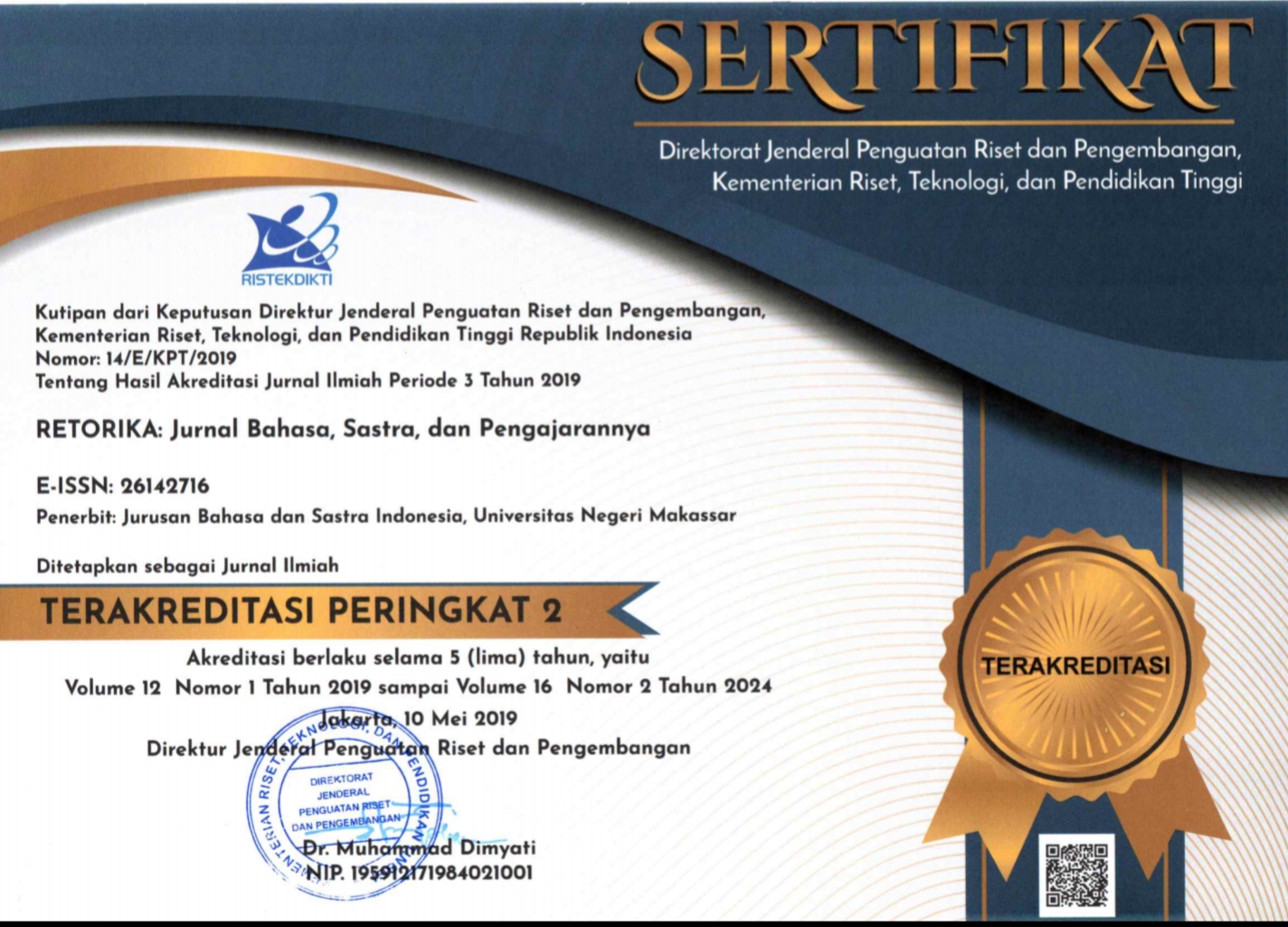VALUES FROM AN ANTAGONIST: ERIK’S FAVORABLE CHARACTERS FROM LEROUX’S THE PHANTOM OF THE OPERA
(1) Universitas Pendidikan Ganesha
(2) Universitas Pendidikan Ganesha
(*) Corresponding Author
DOI: https://doi.org/10.26858/retorika.v17i1.53972
Abstract
Keywords
Full Text:
PDFReferences
Andrahennadi, K. C. (2019). Mindfulness-Based Design Practice (MBDP): A Novel Learning Framework in Support of Designers within Twenty-First-Century Higher Education. International Journal of Art and Design Education, 38(4), 887–901. https://doi.org/10.1111/jade.12272
Angellia, M. (2017). Love obsession in Gaston Leroux’s The Phantom of the Opera [Catholic University of Widya Mandala]. In The Faculty of Letters Catholic University of Widya Mandala. http://i-lib.ugm.ac.id/jurnal/download.php?dataId=2227%0A???%0Ahttps://ejournal.unisba.ac.id/index.php/kajian_akuntansi/article/view/3307%0Ahttp://publicacoes.cardiol.br/portal/ijcs/portugues/2018/v3103/pdf/3103009.pdf%0Ahttp://www.scielo.org.co/scielo.php?scri
Anindyarini, A., Rokhman, F., Mulyani, M., & Andayani, P. (2017). Moral Value or Character in Fantasy Story. Advances in Social Science, Education and Humanities Research (ASSEHR), 158(1), 122–129. https://doi.org/10.2991/ictte-17.2017.37
Arqom, S., & Engliana. (2019). The Character and Moral Value in “Spare Parts” by Joshua Davis. Journal of English Language Teaching, 2(2), 187–194.
Aryawan, L. P. K. F., Suwastini, N. K. A., Artini, N. N., Jayantini, I. G. A. S. R., & Adnyani, K. E. K. (2022). Literature for Character Building: What To Teach and How According To Recent Research. Lingua Scientia, 29(2), 59–71. https://doi.org/10.23887/ls.v29i2.41107
Biancorosso, G. (2018). The phantom of the opera and the performance of cinema. Opera Quarterly, 34(2–3), 153–164. https://doi.org/10.1093/oq/kby009
Boyle, G. (2020). The Moral Resilience of Young People Who Care. Ethics and Social Welfare, 14(3), 266–281. https://doi.org/10.1080/17496535.2020.1771606
Chusni, M. M., Saputro, S., Suranto, & Rahardjo, S. B. (2020). The potential of discovery learning models to empower students’ critical thinking skills. Journal of Physics: Conference Series, 1464(1). https://doi.org/10.1088/1742-6596/1464/1/012036
D’Amico, L. E. (2020). What Would Elsie Do?: Educating Young Women About Moral and Academic Power in Martha Finley’s Nineteenth-Century Elsie Dinsmore Series. Children’s Literature in Education, 51(1), 95–109. https://doi.org/10.1007/s10583-018-9356-8
Facione, P. A. (1990). Critical Thinking : A Statement of Expert Consensus for Purposes of Educational Assessment and Instruction Executive Summary “ The Delphi Report. The California Academic Press, 423(c), 1–19.
Frazell, K. (2018). Immortal melancholia : A psychoanalytical study of Byronic heroes. https://doi.org/https://doi.org/10.33015/dominican.edu/2018.hum.10
Handayani, E. A., Sonodihardjo, A. S., & Asmawati, A. (2020). Implementation of Project Citizen Model Based on Character Education To Improve the Critical Thinking Skills. RETORIKA: Jurnal Bahasa, Sastra, Dan Pengajarannya, 13(1), 189. https://doi.org/10.26858/retorika.v13i1.11184
Henry, B. C. (2013). The Philosophy of Meaning and Value. ARPN Journal of Science and Tecnology, 3(6), 6.
Jayantini, I. G. A. S. R., Umbas, R., & Suwastini, N. K. A. (2022). Narasi keseimbangan di Bali dalam novel Eat Pray Love karya Elizabeth Gilbert ( The narrative of balance in Bali represented in the novel Eat Pray Love by Elizabeth Gilbert ). KEMBARA: Jurnal Keilmuan Bahasa, Sastra, Dan Pengajarannya, 7(2), 86–99.
Kabugi, P. (2020). An Overview of the Causes of Suicide and Preventive Strategies in Kenyan Universities. African Research Journal of Education and Social Sciences, 6(3), 1–14.
Karali, S. N. (2020). Musical affect and the emotion–cognition interaction in The Phantom of the Opera. Neohelicon, 47(1), 249–263. https://doi.org/10.1007/s11059-020-00525-2
Letseka, M., & Zireva, D. (2013). Thinking: Lessons from John Dewey’s How We Think. Academic Journal of Interdisciplinary Studies, July. https://doi.org/10.5901/ajis.2013.v2n2p51
Lugovtsova, M. Y. (2017). Influence of Novel by Gaston Leroux “The Phantom of the Opera” on Art in the 20th—21st Centuries. Nauchnyy Dialog, 8, 179–190. https://doi.org/10.24224/2227-1295-2017-8-179-190
Manjorang, T., Sembiring, Y. B., & Sitanggang, M. (2021). Moral Value and Character Building Tugu Silalahi Batak Toba Folklore into Teaching Materials English Subject. LEEA : Linguistic, English Education and Art, 4(2), 328.
McKee, A. (2003). Textual Analysis: A beginner’s guide. SAGE Publications.
Miles, M. B., Huberman, A. M., & Saldana, J. (2014). Qualitative data analysis: A methods sourcebook (H. Salmon, K. Perry, K. Koscielak, & L. Barret (eds.); 3rd ed.). SAGE Publications.
Moura, C. N. de, Martinez, L. Y. de L., & Rebello, L. S. (2018). From the damsel in distress to the female hero: The wanderings of Christine Daaé in Gaston Leroux’s the Phantom of the Opera and its last film adaptation. Itinerários, 47, 101–117.
Novak, I., & Mahmutefedic, I. (2020). What Good is Philosophy? Journal of Education Culture and Society, 6(2), 11–19. https://doi.org/10.15503/jecs20152.11.19
Novianti, N. (2017). Teaching character education to college students using bildungsromans. International Journal of Instruction, 10(4), 255–272. https://doi.org/10.12973/iji.2017.10415a
Paz, F. R. (2015). Musical analysis of “The Phantom of the Opera” medley for chorus by Andrew Lloyd Webber arranged by Ed Lojeski (Analisis musik medley “The Phantom of the Opera” untuk paduan suara karya Andrew Lloyd Webber aransemen Ed Lojeski). Universitas Pendidikan Indonesia.
Possin, K. (2017). Thinking Critically About Richard Paul’s Critical Thinking . Association for Informal Logic and Critical Thinking, 1(1), 1–10.
Putri, A. R. H. C., & Khoiri, M. (2015). Erik’s Oppression in Gaston Leroux’s The Phantom of the Opera. Litera Kultura, 3(2), 1–11.
Qomariyah, U., & Neina, Q. A. (2020). the Construction of Children Moral Reasoning in Strengthening Self-Control. RETORIKA: Jurnal Bahasa, Sastra, Dan Pengajarannya, 13(2), 246–255. https://doi.org/10.26858/retorika.v13i2.12436
Raharto, R. D., & Permatasari, R. (2019). The protagonist’s shadow and persona as the reflection of anti-hero in The Phantom of the Opera novel retold by Diane Namm. EduLite: Journal of English Education, Literature and Culture, 4(1), 65–75. https://doi.org/10.30659/e.4.1.65-75
Reeder, H. (1984). The Nature of Critical Thinking. Informal Logic, 6(2), 1–8. https://doi.org/10.22329/il.v6i2.2729
Schultz, A. (2020). Sitting Still and Reading: Rethinking the Role of Literary Fiction in Civics Education. Educational Theory, 70(2), 187–198. https://doi.org/10.1111/edth.12415
Schut, A., Klapwijk, R., Gielen, M., & de Vries, M. (2019). Children’s Responses to Divergent and Convergent Design Feedback. Design and Technology Education: An International Journal, 24(2), 67–89.
Seventika, S. Y., Sukestiyarno, Y. L., & Mariani, S. (2018). Critical thinking analysis based on Facione (2015) - Angelo (1995) logical mathematics material of vocational high school (VHS). Journal of Physics: Conference Series, 983(1). https://doi.org/10.1088/1742-6596/983/1/012067
Sittika, A. J., Karawang, U. S., Syahid, A., & Karawang, U. S. (2021). Strengthening humanistic based character education through local values and Islamic education values in basic education units in purwakarta regency. İlköğretim Online, 20(2), 22–32. https://doi.org/10.17051/ilkonline.2021.02.06
Sternberg, R. J., Roediger, H. L., & Halpern, D. F. (2006). Critical thinking in psychology. Critical Thinking in Psychology, 423(c), 1–340. https://doi.org/10.1017/CBO9780511804632
Sternfeld, J. (2016). “Pitiful creature of darkness”: The subhuman and the superhuman in The Phantom of the Opera. In B. Howe, S. J.- Moulton, N. Lerner, & J. Straus (Eds.), The Oxford Handbook of Music and Disability Studies (pp. 795–814). Oxford University Press.
Sundström, M., & Jola, C. (2021). “I’m Never Going to Be in Phantom of the Opera”: Relational and Emotional Wellbeing of Parkinson’s Carers and Their Partners in and Beyond Dancing. Frontiers in Psychology, 12(July), 1–17. https://doi.org/10.3389/fpsyg.2021.636135
Suprapto, E., Fahrizal, F., Priyono, P., & K., B. (2017). The Application of Problem-Based Learning Strategy to Increase High Order Thinking Skills of Senior Vocational School Students. International Education Studies, 10(6), 123. https://doi.org/10.5539/ies.v10n6p123
Suwastini, N. K. A., Dewi, N. K. J., Saputra, N. P. H., & Myartawan, I. P. N. W. (2022). A mouse’s courage: The characterizations of the Boy in Roald Dahl’s The Witches. Yavana Bhasha : Journal of English Language Education, 5(2), 118–131. https://doi.org/10.25078/yb.v5i2.1046
Suwastini, N. K. A., Widasuari, N. W. D., Wahyuni, L. G. E., & Visestayati, N. P. A. (2020). Lucy Pevensie’s characterizations in C.S. Lewis’ Narnia: The Lion, the Witch, and the Wardrobe. International Journal of Language and Literature, 4(1), 47. https://doi.org/10.23887/ijll.v4i1.30227
Värnik, P. (2012). Suicide in the world. International Journal of Environmental Research and Public Health, 9(3), 760–771. https://doi.org/10.3390/ijerph9030760
Wallner, L., & Barajas, K. E. (2020). Using comics and graphic novels in k-9 education: An integrative research review. Studies in Comics, 11(1), 37–54. https://doi.org/10.1386/jem_00014_1
Wardhani, S. G. (2012). Love desire of Erik in Gaston Leroux’s novel The Phantom of the Opera (1911): A pychoanalytic approach. In School of Teacher Training and Education Muhammadiyah University of Surakarta (Issue August). Muhammadiyah University of Surakarta.
Widodo, M., Supriatna, U., & Sumadi. (2021). Strengthening Education Characters of Environmental Care in The Faculty of Teacherry And Education Pgri University of Ronggolawe (Unirow) Tuban. İlköğretim Online, 20(3), 140–151. https://doi.org/10.17051/ilkonline.2021.03.14
Wulansari, C. D. S., & Hidayat, A. (2020). Characterization Analysis Of The Main Character Of The Secret Garden. Wanastra, 8(2), 37–45.
Article Metrics
Abstract view : 92 times | PDF view : 15 timesRefbacks
- There are currently no refbacks.
Copyright (c) 2024 Ni Komang Arie Suwastini, Putu Yoga Sathya Pratama

This work is licensed under a Creative Commons Attribution-NonCommercial 4.0 International License.
Published by:
Department of Indonesian Language, Faculty of Languages and Literature, Universitas Negeri Makassar in cooperate with Asosiasi Dosen Bahasa dan Sastra Indonesia (ADOBSI) and Ikatan Program Studi Pendidikan Bahasa dan Sastra Indonesia (IKAPROBSI).
Address: Department of Indonesian Language Office, DG Building Second Floor, UNM Parangtambung, Daeng Tata Raya Street, Makassar, South Sulawesi, Indonesia
 Email: retorika@unm.ac.id
Email: retorika@unm.ac.id

RETORIKA: Jurnal Bahasa, Sastra,dan Pengajarannya is licensed under a Creative Commons Attribution-NonCommercial 4.0 International License.
















